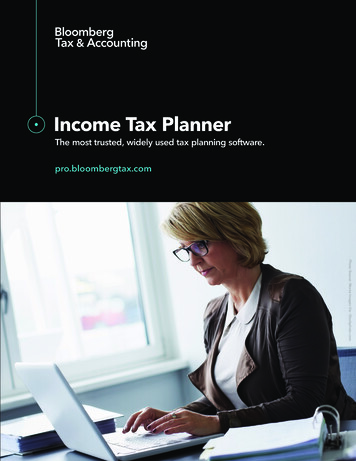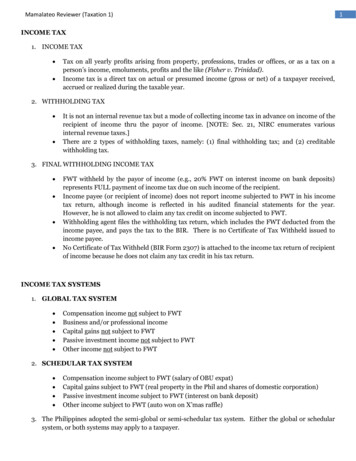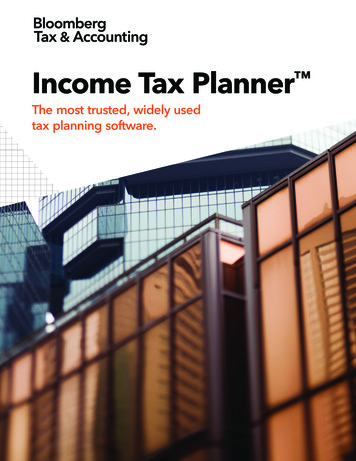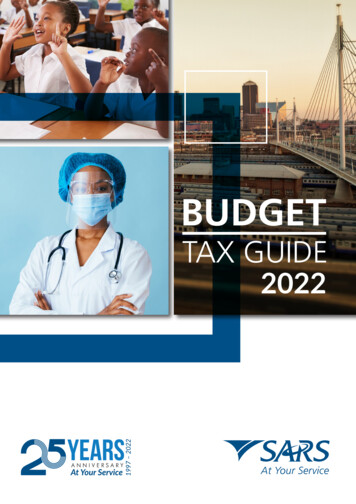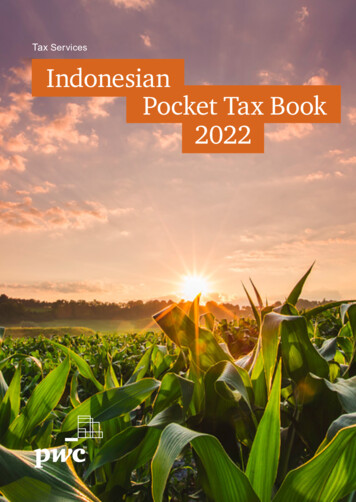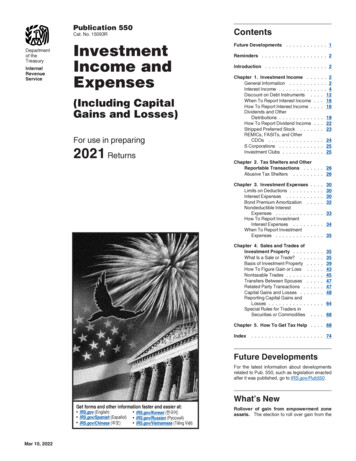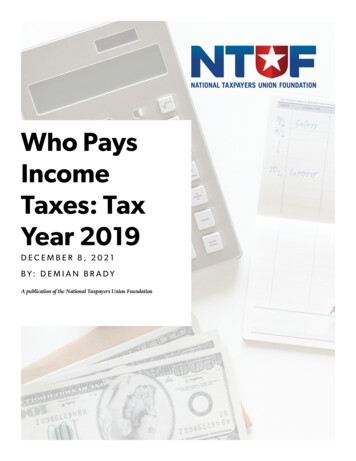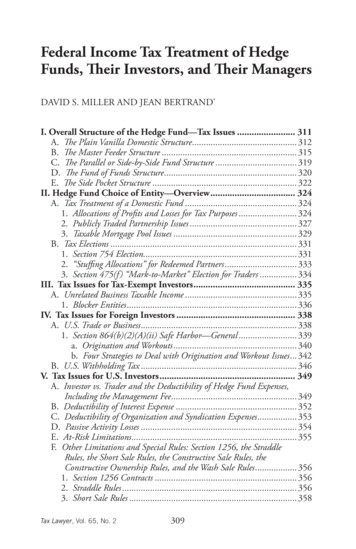
Transcription
Federal Income Tax Treatment of Hedge Funds309Federal Income Tax Treatment of HedgeFunds, Their Investors, and Their ManagersDAVID S. MILLER AND JEAN BERTRAND*I. Overall Structure of the Hedge Fund—Tax Issues. 311A. The Plain Vanilla Domestic Structure.312B. The Master Feeder Structure.315C. The Parallel or Side-by-Side Fund Structure.319D. The Fund of Funds Structure.320E. The Side Pocket Structure.322II. Hedge Fund Choice of Entity—Overview. 324A. Tax Treatment of a Domestic Fund.3241. Allocations of Profits and Losses for Tax Purposes.3242. Publicly Traded Partnership Issues.3273. Taxable Mortgage Pool Issues.329B. Tax Elections.3311. Section 754 Election.3312. “Stuffing Allocations” for Redeemed Partners.3333. Section 475(f ) “Mark-to-Market” Election for Traders.334III. Tax Issues for Tax-Exempt Investors. 335A. Unrelated Business Taxable Income.3351. Blocker Entities.336IV. Tax Issues for Foreign Investors. 338A. U.S. Trade or Business.3381. Section 864(b)(2)(A)(ii) Safe Harbor—General.339a. Origination and Workouts.340b. Four Strategies to Deal with Origination and Workout Issues.342B. U.S. Withholding Tax.346V. Tax Issues for U.S. Investors. 349A. Investor vs. Trader and the Deductibility of Hedge Fund Expenses,Including the Management Fee.349B. Deductibility of Interest Expense.352C. Deductibility of Organization and Syndication Expenses.353D. Passive Activity Losses.354E. At-Risk Limitations.355F. Other Limitations and Special Rules: Section 1256, the StraddleRules, the Short Sale Rules, the Constructive Sale Rules, theConstructive Ownership Rules, and the Wash Sale Rules.3561. Section 1256 Contracts.3562. Straddle Rules.3563. Short Sale Rules.358Tax Lawyer, Vol. 65, No. 2309
310 SECTION OF TAXATION4. Constructive Sale Rules.3585. Constructive Ownership Rules.3596. Wash Sale Rules.360G. The Disadvantages and Advantages for U.S. Taxable Investors ofInvesting in a Foreign Blocker—as Opposed to a U.S. Feeder.3601. The Disadvantages of Investing Through a Foreign Corporation.360a. No Pass-Through of Losses.361b. No Pass-Through of Capital Gains—Controlled ForeignCorporations and Passive Foreign Investment Companies.361c. The PFIC on a PFIC Rules.363d. Dividend—and Other—Withholding Tax.363e. U.S. Trade or Business Risk.364f. No U.S. Foreign Tax Credits for Individuals, or forCorporations with Less than 10% of the Voting Power.364g. Additional Filings—FATCA Reporting Requirements for“Foreign Financial Institutions.364h. Additional Filings—Service Form 926.369i. Additional Filings—Service Form 5471.369j. Additional Filings—Service Form 8621.370k. Additional Filings—Specified Foreign Financial AssetReporting.370l. Additional Filings—FBAR.3712. The Advantages of Investing Through a Foreign Corporation.372a. Avoid Federal Limitations on Miscellaneous ItemizedDeductions for Regular and Alternative MinimumTax Purposes.373b. Avoid the Proposal to Limit Itemized Deductions to 28%.373c. State Tax Deferral.374d. Avoid State Law Limitations on Deductions.374e. Avoid Limitations on Interest Expense.374f. Avoid Limitations on Deductibility of Organization andSyndication Expenses.375g. Avoid Limitations on Capital Loss Deductibility.375h. Avoid the Straddle Rules and the Wash Sale Rules.376i. Avoid Other Limitations on Deductibility of Expenses—Such as AHYDO.376VI. Tax Issues for the General Partner and the InvestmentManager. 377A. Choice of Entity for the General Partner and the InvestmentManager.377B. Compensation Issues for the Manager.3771. Current Federal Income Tax Law.3772. The Carried Interest Revenue Proposal.379C. Deferral of Management Fees from Offshore Entities.382Tax Lawyer, Vol. 65, No. 2
Federal Income Tax Treatment of Hedge Funds3111. Carried Interest as a Fee.3822. Section 457A—Nonqualified Deferred Compensation.382D. Self-Employment Tax.384E. New York City Unincorporated Business Tax.386VII. Conclusion. 387Exhibits. 388I. Overall Structure of the Hedge Fund—Tax IssuesThe structure of a hedge fund is generally designed to be tax and administratively efficient, and is largely dependent upon the classes of investors—for example, U.S. taxable, foreign, and U.S. tax-exempt—the asset classes,and sometimes upon the jurisdictions in which the individual investmentmanagement professionals will be located—such as structuring necessary tominimize the New York City unincorporated business tax.A group of individual investment professionals will manage the hedgefund’s portfolio and will also function as its general partner. In most casesthe investment professionals will form two entities, both treated as partnerships for U.S. federal income tax purposes: one entity—the “investmentmanager”—to manage the portfolio and receive management fees—that is,the “2” in a 2/20 compensation structure—and a different entity—the “general partner”—to receive incentive compensation in the form of a carriedinterest—the “20” in a 2/20 compensation structure.The individual investment professionals will often be limited partners inboth entities but pay self-employment tax only on their interest in the entityreceiving the management fees—the investment manager—and then onlywith respect to their general partnership interest in the investment manager.They will not typically pay self-employment tax1 with respect to the incomeand gain allocated to them under the carried interest held by the general partner entity. In addition, individual investment professionals located in NewYork City will typically pay New York City unincorporated business tax2 onlyon the earnings of the investment manager—the management fees.David S. Miller is a Partner in the New York, NY, office of Cadwalader, Wickersham &Taft LLP. He has a B.A. from the University of Pennsylvania (1986), a J.D. from Columbia University Law School (1989), and an LL.M. from New York University School of Law(1994). Jean Bertrand is Special Counsel in the New York, NY, office of Cadwalader, Wickersham & Taft LLP. She has a B.S. from the State University of New York—Geneseo (1993), aJ.D. from the University of Pennsylvania Law School (1999), and an LL.M. from New YorkUniversity School of Law (2006).The authors thank Janicelynn Asamoto, Shlomo Boehm, Ari Brandes, Lindsey Goble,Charles Kaufman, Harley Raff, Jamie Saeli, Jason Schwartz, Karen Walny, and Jennifer Wetzelfor their helpful contributions to this Article.1See infra Part VI.D for a discussion on the self-employment tax.2See infra Part VI.E for a discussion on the New York City unincorporated business tax.*Tax Lawyer, Vol. 65, No. 2
312 SECTION OF TAXATIONThere are five common hedge fund structures. This Part describes thosestructures, the rationale behind each structure, and the situations for whicheach structure is best suited.A. The Plain Vanilla Domestic StructureIf all of the investors in a hedge fund will be U.S. taxable investors, then thefund is generally structured as a single limited partnership or limited liabilitycompany that is treated as a partnership for U.S. federal income tax purposes.The investors in the fund are treated as partners in the partnership for U.S.federal income tax purposes.Plain Vanilla Domestic StructureIndividualInvestment Professionals(Limited Partners)LLCLLCGeneralPartner ofInvestment mentManagerU.S. andForeign Investors(Limited There are several reasons to use an entity that is treated as a partnershipfor U.S. federal income tax purposes. First, partnerships are not subject toTax Lawyer, Vol. 65, No. 2
Federal Income Tax Treatment of Hedge Funds313an entity level tax. Instead, each partner reports its allocable share of thepartnership’s income, gain, loss, deduction, and credit in its income for eachyear.3 So, if a hedge fund incurs losses during the year, a partnership structuremay allow the investors to claim their share of these losses which, subject tolimitations, may be used by investors to offset their other, nonfund income.Second, the character of partnership income, gain, loss, deduction, and creditpasses through to its partners.4 Thus, if a partnership earns long-term capital gains or qualified dividend income and allocates a portion of these gainsor dividends to a partner, the partner will report long-term capital gains orqualified dividend income.Finally, and importantly, if the individual members of the managementteam receive a portion of their compensation in the form of a “carried interest” or a “profits interest” in a partnership—the “20” of a “2/20” compensation structure5—allocated to the general partner, they may avoid reportingthe value of the carried interest in income and avoid section 457A, whichapplies only to contingent fees and does not apply to carried interests.6 Moreover, under current law, any allocations of long-term capital gains or qualifieddividend income to the general partner as part of its carried interest wouldretain their character in the hands of the individual members of the generalI.R.C. §§ 701–702.I.R.C. § 702(b).5The management team typically receives two types of compensation in return for structuring the hedge fund and managing its assets. In a “2/20” compensation structure, the “2” andthe “20” refer to each of the components. First, the investment manager receives a periodicmanagement fee normally calculated as a percentage of the fund’s net asset value at the timethe fee is paid. The typical fee ranges from 1% to 2% per year. This portion of the manager’scompensation is the “2” of the “2/20.” The fee does not depend upon the performance of thefund and is generally characterized as ordinary income and taxed at ordinary income tax rates.Second, the general partner, which is ordinarily affiliated with the investment manager, typically receives a performance payment in exchange for services provided to the fund, such as20% of the fund’s profits. This portion of the management team’s compensation is the “20” ofthe “2/20.” This portion of the compensation, referred to as the “carry” or “carried interest” isoften structured as a “profits interest” in the partnership.6I.R.C. § 457A; see infra Part VI.C.2.34Tax Lawyer, Vol. 65, No. 2
314 SECTION OF TAXATIONpartner and be subject to tax at reduced rates.7However, legislation was introduced to change this last benefit of partnership treatment.8 Although this legislation was not enacted, the ObamaAdministration has proposed ordinary income treatment for carried interests7The maximum rate of tax paid by an individual taxpayer on its net long-term capital gainsand qualified dividends is 15%. This 15% rate is scheduled to expire for taxable years beginning after December 31, 2012. See Economic Growth and Tax Relief Reconciliation Act of2001, Pub. L. No. 107-16, § 901, 115 Stat. 38, 150, amended by Tax Relief, UnemploymentInsurance Reauthorization, and Job Creation Act of 2010, Pub. L. No. 111-312, § 101(a)(1),124 Stat. 3296, 3298. Accordingly, unless the law changes, in 2013, the maximum rate oftax on the net long-term capital gains of individuals will increase to 20% and all dividends—including qualified dividends—will be taxed at an ordinary income rate of 39.6%. The ObamaAdministration’s Revenue Proposals for the Fiscal Year 2013 would allow the 15% tax rateapplicable to net long-term capital gains to expire for high income individuals, resulting ina 20% tax rate on these gains, and would tax all dividends at ordinary income rates. SeeOffice of Management and Budget, Executive Office of the President, Budget of theU.S. Government Fiscal Year 2013 (Feb. 2012) [hereinafter OMB Executive Budget 2013],available at budget/fy2013/assets/budget.pdf; Dep’t of the Treasury, General Explanations of the Administration’s Fiscal Year 2013 Revenue Proposals (Feb. 2013) [hereinafter Treasury Revenue Explanations 2013], available cy/Documents/general-explanations-fy2013.pdf. The proposal to tax qualified dividends at ordinary income rates is new. However, theObama Administration has proposed a maximum net long-term capital gains tax rate of 20%every year in every year’s budget since fiscal year 2010. See Office of Management and Budget, Executive Office of the President, Budget of the U.S. Government Fiscal Year 2012(Feb. 2011) [hereinafter OMB Executive Budget 2012], available at UDGET-2012-BUD.pdf; Dep’t of the Treasury,General Explanations of the Administration’s Fiscal Year 2012 Revenue Proposals (Feb. 2011)[hereinafter Treasury Revenue Explanations 2012], available at /documents/general-explanations-fy2012.pdf; Office of Management and Budget, Executive Office of the President, Budget of the U.S. GovernmentFiscal Year 2011 (Feb. 2010) [hereinafter OMB Executive Budget 2011], available at UDGET-2011-BUD.pdf; Dep’t of theTreasury, General Explanations of the Administration’s Fiscal Year 2011 Revenue Proposals (Feb.2010) [hereinafter Treasury Revenue Explanations 2011], available at /documents/general-explanations-fy2011.pdf; Office of Management and Budget, Executive Office of the President, Budget of the U.S. GovernmentFiscal Year 2010 (Feb. 2009) [hereinafter OMB Executive Budget 2010], available at UDGET-2010-BUD.pdf; Dep’t ofthe Treasury, General Explanations of the Administration’s Fiscal Year 2010 Revenue Proposals(Feb. 2009) [hereinafter Treasury Revenue Explanations 2010], available at /documents/general-explanations-fy2010.pdf. Finally,beginning in 2013, U.S. individuals will be subject to an additional 3.8% “Medicare tax” ontheir “net investment income” to the extent that their net investment income, when added totheir other modified adjusted gross income, exceeds 200,000 for an unmarried individual, 250,000 for a married taxpayer filing a joint return—or a surviving spouse—or 125,000 fora married individual filing a separate return. I.R.C. § 1411. Net investment income generallyincludes interest, dividends, and net capital gains. I.R.C. § 1411(c).8See infra Part VI.G.2.Tax Lawyer, Vol. 65, No. 2
Federal Income Tax Treatment of Hedge Funds315in the most recent budget proposals.9Despite the benefits of a partnership structure for U.S. taxable investors,there is an increasing number of reasons why U.S. taxable investors may prefer to invest in a hedge fund through an entity that is treated as a foreigncorporation for U.S. federal income tax purposes.10B. The Master Feeder StructureIf, in addition to U.S. taxable investors, a hedge fund’s investors will includeforeigners, or if the investors will include pension plans, foundations, or otherU.S. tax-exempt organizations, and the fund will borrow to make its investments, then a “master feeder” structure may make sense.In a typical master feeder structure, a “master fund” is formed offshore ina low-tax jurisdiction as a partnership or as a corporation that checks the boxto be treated as a partnership for U.S. federal income tax purposes.11 The master fund constitutes the main investing entity and holds the fund’s portfolioof stocks and securities. The master fund is typically organized offshore forwithholding tax reasons. If the master fund is a domestic entity treated as apartnership for tax purposes, it would be the withholding agent and would berequired to withhold and make payments to the Service on any U.S.-sourceincome with respect to which withholding is required, such as U.S.-source9See OMB Executive Budget 2013, supra note 7; Treasury Revenue Explanations2013, supra note 7; see also infra Part VI.B.2. The Obama Administration has introducedsimilar proposals in preceding Fiscal Years. See OMB Executive Budget 2012, supra note 7;Treasury Revenue Explanations 2012, supra note 7; OMB Executive Budget 2011, supranote 7; Treasury Revenue Explanations 2011, supra note 7; OMB Executive Budget2010, supra note 7; Treasury Revenue Explanations 2010, supra note 7.10See infra Part V.G.11The check-the-box regulations allow certain entities to elect their tax characterization—asa disregarded entity or partnership on the one hand, or a corporation on the other—for U.S.federal income tax purposes by filing an election with the Service. Domestic partnerships andlimited liability companies are treated as disregarded entities—if they have only one member—or as partnerships—if they have two or more members—for U.S. federal income taxpurposes but may elect to be treated as corporations for U.S. federal income tax purposes byfiling Form 8832 with the Service. Reg. § 301.7701-3(b)(1), -3(c). A business entity organized or incorporated under federal or state law as a corporation may not elect to be treatedas other than a corporation for U.S. federal tax purposes. Reg. §§ 301.7701-2(b)(1), -3(a). Aforeign entity that provides all of its members with limited liability and certain foreign entities specifically identified in the check-the-box regulations as per se corporations are treated ascorporations for U.S. federal income tax purposes. Reg. §§ 301.7701-2(b)(8), -3(b)(2)(i)(B).However, if at least one owner of a foreign entity has personal liability, the entity is treatedas a partnership for U.S. federal income tax purposes or a disregarded entity if it has just asingle owner. Reg. § 301.7701-3(b)(2)(i)(A). The check-the-box regulations allow a foreignentity that is not a per se corporation to elect out of its default classification by filing a Form8832 with the Service. Reg. § 301.7701-3(c). Because the default characterization of foreignentities to some extent depends upon the interpretation of non-U.S. law—whether a memberhas limited liability—foreign hedge funds will often file a protective check-the-box election toensure that they are characterized in accordance with their intent for U.S. federal income taxpurposes.Tax Lawyer, Vol. 65, No. 2
316 SECTION OF TAXATIONdividends and nonportfolio interest, allocable to its foreign investors—theforeign feeder described below.12 On the other hand, if the master fund isorganized offshore, the broker or issuer making payments to the master fundwould be the withholding agent for federal tax purposes.13 In addition, if themaster fund could be treated as a taxable mortgage pool, organizing the master fund offshore can avoid a U.S. federal corporate income tax.14The master fund, in turn, has two limited partners. The first limited partner is usually an entity that is organized in a low-tax jurisdiction and is treatedas a corporation for U.S. federal income tax purposes. Foreigners and taxexempt organizations invest in this entity, which is called the “foreign feeder.”Investing through an entity that is treated as a foreign corporation for U.S.tax purposes allows tax-exempt organizations to avoid incurring unrelatedbusiness taxable income (UBTI) as a result of the fund’s borrowing, limits therisk that foreigners will be treated as engaged in a U.S. trade or business fortax purposes by reason of the master fund’s activities, and limits the possibility that the master fund’s trade or business activities will taint the foreigners’unrelated income.15The second limited partner of the master fund is typically a limited liability company or limited partnership that is treated as a partnership for U.S.federal income tax purposes—similar to the plain vanilla domestic fund. U.S.taxable investors invest through this entity, which is commonly called the“domestic feeder.” However, some structures permit U.S. taxable investors to12See Reg. § 1.1441-5(b)(1) (if a withholding agent can reliably associate a Service FormW-9 provided by a U.S. partnership, “the withholding agent may treat the payment as made toa U.S. payee and the payment is not subject to withholding under section 1441” even thoughthe partnership may have foreign partners); Reg. § 1.1441-5(b)(2) (stating a U.S. partnershipis required to withhold as a withholding agent on an amount subject to withholding that is“includible in the gross income of a partner that is a foreign person”).13See Reg. § 1.1441-5(c) (payees of a payment to a nonwithholding foreign partnership arethe partners).14See infra Part II.A.3 (discussing taxable mortgage pools).15See infra Parts III and IV.Tax Lawyer, Vol. 65, No. 2
Federal Income Tax Treatment of Hedge Funds317invest directly in the offshore master fund.16The master feeder structure is efficient because it permits hedge fund managers to pool the assets of investors with varied tax objectives, thereby reducing administrative expenses.The investment manager may receive fees from the master fund or fromeach of the feeder funds and will typically receive its carried interest from themaster fund.1716As an administrative matter, however, it may be simpler to have U.S. taxable investorsinvest through an entity that is treated as a domestic partnership for U.S. federal income taxpurposes. This is because the master fund will need to provide to any person from which itwill receive payments—for example, to brokers or to banks in order to open bank accounts—aForm W-8IMY with attachments of Forms W-8s and W-9s from all of its investors and awithholding statement allocating income to each investor. Accordingly, each time its investorcomposition changes, the master fund will have to update the Service forms and withholdingstatement provided to payors. Instead, if all U.S. taxable investors invest through a domesticentity that is treated as a partnership, then the domestic partnership will provide a single FormW-9 on behalf of itself to the master fund and the investor base of the master fund will consistsolely of the domestic feeder and the offshore feeder funds. In addition, U.S. investors whoinvest directly in an offshore master fund may have additional filing requirements as a result ofowning an interest in a foreign entity. See I.R.C. § 6046A (certain U.S. taxable investors withcontrolling interests in foreign partnerships must file Service Form 8865); I.R.C. § 6038D(individuals must report on their annual tax returns specified foreign financial assets, including interests held in a foreign hedge fund and other “foreign financial accounts” (discussedinfra Part V.G.1.g), exceeding, in the aggregate, 50,000 in value; the form for this reportingrequirement has yet to be issued by the Service); Dep’t of the Treasury, Report of ForeignBank and Financial Accounts, Form TD F 90-22.1 (Jan. 2012)(discussed infra Part V.G.1.g).17As described above, to minimize federal self-employment tax and New York City unincorporated business tax if the investment manager is located in New York City, one entity wouldtypically serve as the investment manager of the master fund and a second entity as the generalpartner of the master fund and the domestic feeder fund.Tax Lawyer, Vol. 65, No. 2
318 SECTION OF TAXATIONMaster Feeder StructureIndividualInvestment Professionals(Limited Partners)LLCLLCGeneralPartner ofInvestment ManagerGeneralPartnerLPperformanceallocationU.S. TaxableInvestors(Limited agementfeesTax-Exempt andForeign Investors(Shareholders)ForeignFeeder Fund(Limited Partner)DomesticFeeder Fund(Limited Partner)MasterFundInvestmentsTax Lawyer, Vol. 65, No. 2
Federal Income Tax Treatment of Hedge Funds319C. The Parallel or Side-by-Side Fund StructureAs an alternative to the master feeder structure, a foreign fund and a domestic fund may be organized to operate separately but to invest alongside eachother using a “parallel fund” or “side-by-side” structure. The parallel fundstructure achieves many of the same tax efficiencies and attracts a similar setof investors as the master feeder structure. However, a parallel fund structureallows investment managers to manage the two funds differently to take intoaccount restrictions with respect to the foreign fund that are designed to prevent it from being treated as “engaged in a trade or business in the UnitedStates” for federal income tax purposes, which would subject the foreign fundto U.S. federal corporate income tax and possibly state and local taxes andrequire the filing of U.S. federal tax returns.18Frequently, the foreign fund in a parallel fund structure will, in turn, investin a foreign entity that checks the box to be treated as a partnership for U.S.tax purposes. This entity is commonly referred to as a “mini-master fund” ora “mini-master.” The investment manager receives its incentive compensationin the form of a carried interest in the mini-master and thereby obtains thebenefits of a carried interest19 and avoids section 457A.20Reg. § 1.482.7; see infra Part IV.A.See infra Part VI.B.20See infra Part VI.C.2.1819Tax Lawyer, Vol. 65, No. 2
320 SECTION OF TAXATIONSide-By-Side StructureIndividualInvestment Professionals(Limited Partners)LLCLLCGeneralPartner ofInvestment ManagerGeneralPartnerLPperformanceallocationU.S Taxables(Limited Partners)InvestmentManagermanagementfeesTax-Exempt andForeign erformanceallocationForeign Feeder FundForeignFundD. The Fund of Funds StructureA “fund of funds” is a hedge fund that invests in a portfolio of other hedgefunds. Investors seeking exposure to several hedge funds within a singleinvestment category or across multiple categories, but that are not able tosatisfy the minimum investment requirements for multiple funds or lack theresources to manage multiple investments, may choose to invest in a fund offunds to achieve greater diversity and less volatility or risk. However, the costof investing in a fund of funds may be higher than the cost of investing inother hedge funds because the manager of the fund of funds typically chargesTax Lawyer, Vol. 65, No. 2
Federal Income Tax Treatment of Hedge Funds321fees, which are in addition to the compensation being paid to the managersof the underlying hedge funds. The fund of funds strategy may be used by aplain vanilla fund, a master fund, or a parallel fund.Domestic Fund of Fund StructureIndividualInvestment Professionals(Limited Partners)LLCLLCGeneralPartner ofInvestment mentManagerU.S. Investors(Limited Partners)managementfeesFundof FundsFundTax Lawyer, Vol. 65, No. 2FundFund
322 SECTION OF TAXATIONE. The Side Pocket StructureMany hedge fun
Federal Income Tax TreaTmenT oF Hedge Funds 313 an entity level tax. Instead, each partner reports its allocable share of the partnership’s income, gain, loss, deduction, and credit in its income for each year.3 so, if a hedge fu

